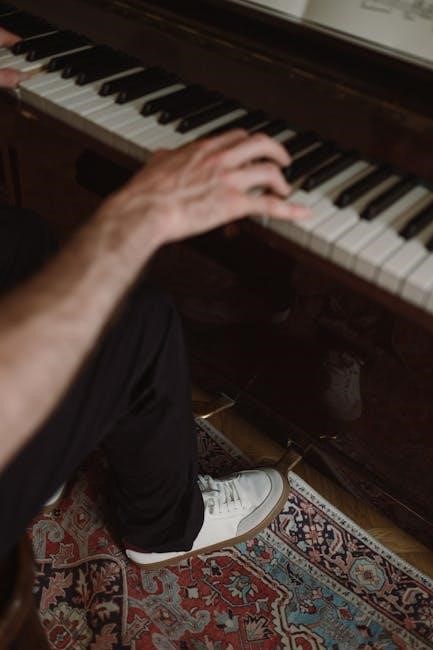Slash chords are essential for pianists, offering a way to add complexity and depth to music. They combine a chord with a specified bass note, enhancing harmonic structure and bass movement.
1.1 Definition of Slash Chords
Slash chords are musical notations indicating a chord played over a specified bass note. They are written as a chord symbol followed by a slash and a bass note, such as D/G. This notation tells the player to perform the D chord with a G in the bass. Slash chords add harmonic complexity and allow for smoother bass line movement, making them versatile in various musical genres. They are particularly useful in piano music for enhancing texture and depth in compositions.
1.2 Importance of Slash Chords in Music
Slash chords are crucial for adding depth and versatility to musical compositions. They enable pianists to specify both the chord and the bass note, enhancing harmonic richness. This notation is essential for directing smooth bass line movement, which is vital in genres like jazz and classical. Slash chords also provide clarity in sheet music, ensuring performers interpret the intended harmony accurately. Their use elevates the complexity and emotional impact of music, making them a valuable tool for composers and musicians alike.
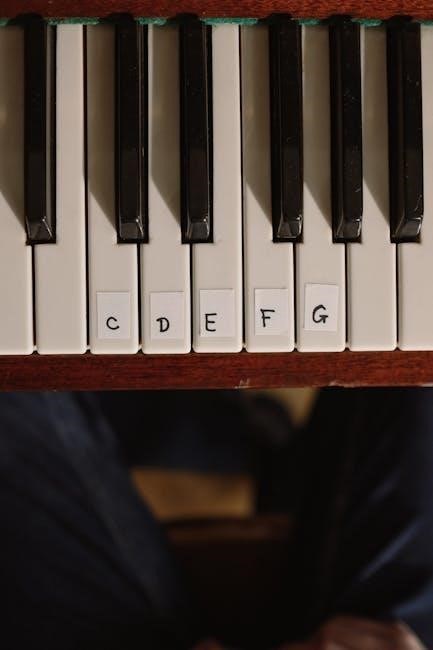
Understanding Slash Chords
Understanding slash chords involves recognizing their structure and purpose. They consist of a chord symbol and a bass note, guiding how the harmony is played.
2.1 What Are Slash Chords?
Slash chords, also known as “chord slashes” or “bass chords,” are musical notations that combine a chord with a specific bass note. They are written as a chord symbol followed by a slash and a note, indicating the desired bass pitch. This notation provides clarity for pianists and keyboardists, ensuring the harmony is played correctly while specifying the bass line movement. Slash chords are essential for precise harmonic and rhythmic execution, especially in jazz, pop, and contemporary music. They guide musicians to play the chord with a specific bass note, enhancing the overall sound.
2.2 Components of a Slash Chord
A slash chord consists of two main components: the chord symbol and the bass note. The chord symbol indicates the harmony, while the bass note specifies the lowest pitch to be played. These components work together to create a unique sound and texture. The chord symbol represents the harmonic structure, and the bass note adds depth and direction to the music. Understanding both components is essential for accurate interpretation and execution of slash chords in piano playing. This combination enhances musical complexity and expression.
2.3 Difference Between Slash Chords and Regular Chords
Slash chords differ from regular chords by specifying a particular bass note, altering the harmonic foundation. Regular chords focus solely on the chord’s notes, while slash chords emphasize a specific inversion or bass line. This distinction allows for greater versatility in harmonic movement and texture. Slash chords often imply a more complex harmonic structure, making them ideal for adding depth and variety in musical arrangements across various genres. They provide clarity in bass line movement, enhancing overall musical expression;
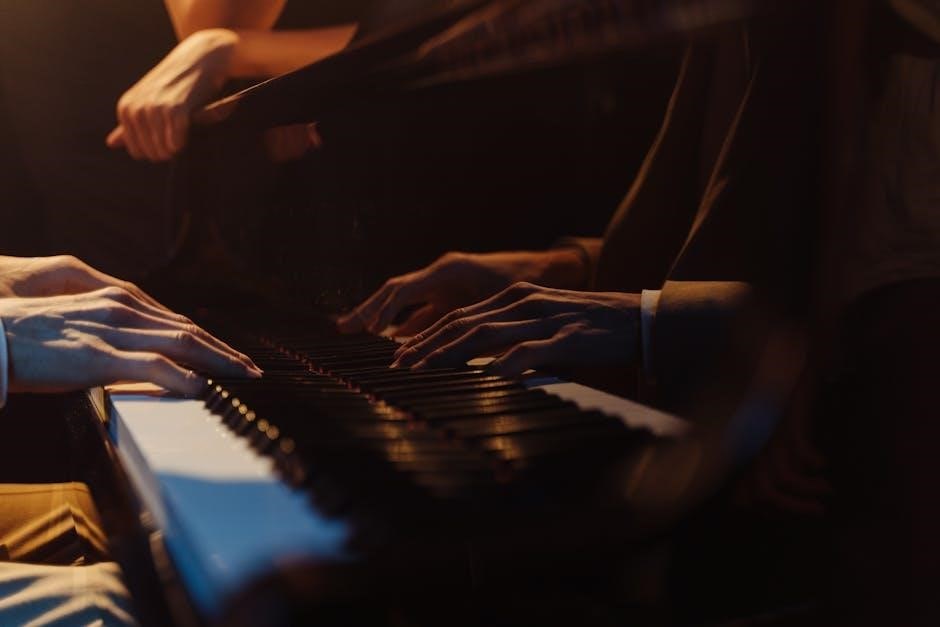
How to Read Slash Chords
Reading slash chords involves understanding the notation and interpreting the bass note. This awareness helps pianists play chords with the correct harmonic and rhythmic accuracy.
3.1 Slash Chord Notation
Slash chord notation is crucial for pianists to understand. It consists of a chord symbol followed by a slash and a bass note, such as C/E. This indicates that the bass should play the note E while the rest of the chord is a C major triad. Properly interpreting this notation ensures harmonic clarity and correct chord voicing, essential for ensemble playing and creating complex, nuanced arrangements in various musical genres.
3.2 Interpreting the Bass Note
Interpreting the bass note in slash chords is essential for accurate performance. The bass note, written after the slash, specifies the root note or inversion to be played in the lower register. For example, in C/E, E is the bass note, altering the chord’s inversion. This ensures the harmonic foundation is clear, allowing the chord to function correctly within the progression. Accurate interpretation enhances the overall sound and maintains rhythmic and harmonic integrity in piano playing.
3.4 Common Examples of Slash Chords
Common slash chords include C/E, G/B, and Am/F. These chords are frequently used in piano music to add harmonic depth. For instance, C/E consists of a C major triad with an E in the bass, creating a distinct harmonic texture. Similarly, G/B emphasizes the note B, altering the chord’s function. These examples demonstrate how slash chords can enhance musicality and versatility, making them essential tools for pianists across various genres.
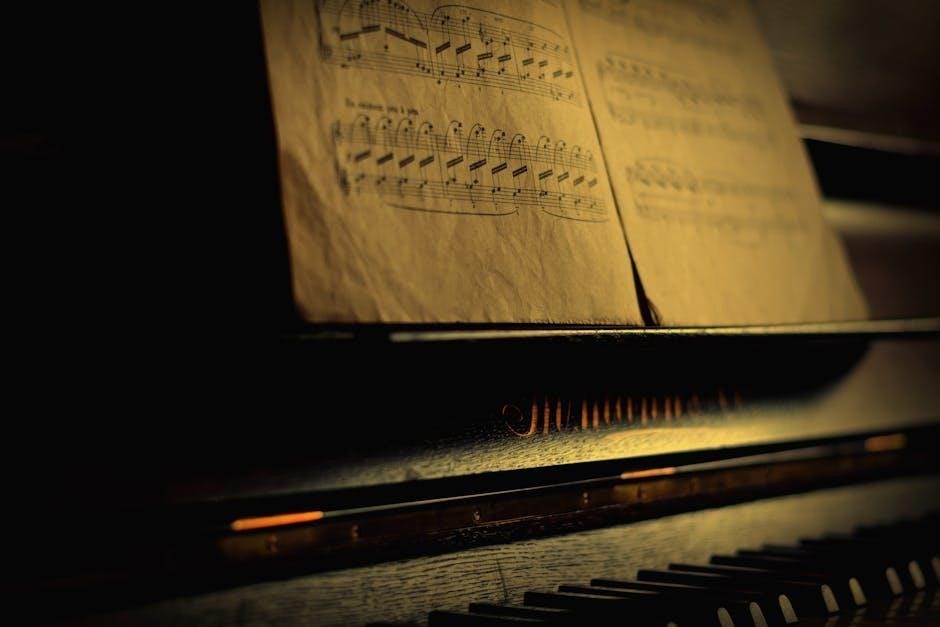
Benefits of Using Slash Chords
Slash chords enhance musical versatility, adding depth and complexity. They transform chord progressions, offering unique harmonic textures and emotional movement, making them invaluable in various musical genres.
4.1 Enhanced Harmonic Complexity
Slash chords introduce enhanced harmonic complexity by altering the traditional chord structure. They allow for the addition of non-chord tones, extensions, and alternative bass notes, creating richer, more intricate soundscapes. This complexity adds depth to progressions, enabling musicians to explore a wider range of emotional expression. By incorporating slash chords, pianists can craft sophisticated harmonies that elevate compositions beyond basic triadic structures, making their music more engaging and dynamic for listeners.
4.2 Improved Bass Line Movement
Slash chords significantly enhance bass line movement by allowing the bass note to change independently of the chord. This creates smoother transitions between chords and adds variety to harmonic progressions. The ability to alter the bass note while maintaining the chord quality leads to more dynamic and engaging bass lines. Pianists can use slash chords to craft bass lines that flow naturally, adding depth and interest to their music. This technique is particularly effective in creating professional-sounding arrangements.
4.3 Versatility in Musical Genres
Slash chords are adaptable across various musical genres, making them a versatile tool for pianists. In jazz, they add harmonic complexity and rhythmic interest. In pop and rock, they enhance bass line movement and chord progressions. Classical music often uses slash chords to create intricate harmonies and bass lines. Their flexibility allows pianists to tailor their sound to fit any genre, making slash chords a valuable asset for musicians seeking to expand their creative possibilities and musical expression.
Playing Slash Chords on the Piano
Mastering slash chords enhances piano playing by combining a triad with a moving bass note, creating rich harmonies and dynamic rhythms in various musical contexts.
5.1 Basic Steps to Play Slash Chords
To play slash chords on the piano, start by identifying the chord symbol and its bass note. Play the bass note with your left hand, then add the chord tones above it. Use your right hand to play the root and third of the chord, ensuring proper voicing for clarity. Practice common progressions to develop muscle memory and fluidity in transitions. This approach enhances harmonic depth and rhythmic movement in your playing.
5.2 Role of the Left and Right Hands
When playing slash chords on the piano, the left hand typically plays the bass note indicated after the slash, while the right hand plays the chord tones above it. The left hand provides the harmonic foundation, anchoring the chord in the key. The right hand adds the root, third, and any extensions, creating a balanced and full sound. This division allows for clear separation between the bass and harmony, enhancing the overall musicality and clarity of the slash chord progression.
5.3 Using Inversions in Slash Chords
Inversions in slash chords involve rearranging the notes of the chord while maintaining the specified bass note. This technique allows for smoother voice leading and harmonic variety. By inverting the chord, the upper notes can be reorganized to create a more fluid transition between chords. Inversions add depth and flexibility to slash chord progressions, enabling pianists to explore different harmonic textures without altering the bass line. This enhances the musicality and expressiveness of the performance.

Common Slash Chords for Piano
This section explores the most frequently used slash chords on the piano, including major, minor, dominant, and altered chords, highlighting their versatility and harmonic richness in various musical genres.
6.1 Major Slash Chords
Major slash chords are essential for pianists, combining a major triad with an alternate bass note. Common examples include C/E, G/D, and F/A, which add harmonic depth without losing the major quality. These chords are widely used in jazz, pop, and classical music to create smooth transitions and emotional richness. By altering the bass note, pianists can enhance progressions while maintaining the chord’s major tonality, making them versatile for improvisation and composition in various musical contexts.
6.2 Minor Slash Chords
Minor slash chords add depth and emotion to music by combining a minor triad with a alternate bass note. Examples include A/C, E/G, and D/F, which create rich, nuanced harmonies. These chords are widely used in jazz, pop, and classical genres to evoke a somber or reflective mood. The altered bass note provides tonal color while maintaining the minor chord’s integrity, making them ideal for complex harmonies and expressive performances in various musical settings.
6.3 Dominant and Altered Slash Chords
Dominant and altered slash chords add tension and color to harmonies. Dominant slash chords, like G7/B, emphasize the dominant function with a moving bass line. Altered chords, such as E7♭5/C, incorporate flattened or sharpened notes for dissonance. These chords are essential in jazz and blues for creating complex, emotionally rich sounds. They allow pianists to explore extended harmonies while maintaining a strong harmonic foundation, making them versatile tools for both improvisation and composed pieces.

Practical Applications of Slash Chords
Slash chords enhance creativity in improvisation, add depth to accompaniments, and solve harmonic challenges. They are versatile tools for musicians seeking to expand their expressive and technical capabilities.
7.1 Improvisation and Creativity
Slash chords offer harmonic flexibility, enabling pianists to explore new sounds during improvisation. By altering the bass note, musicians can create smooth transitions and unexpected harmonic shifts. This technique allows for creative reharmonization of melodies, adding depth and intrigue to solos. For instance, playing a C major chord over a B bass note (C/B) creates a unique, tension-rich sound. Such possibilities encourage experimentation, making slash chords a valuable tool for enhancing improvisational skills and musical expression.
7.2 Accompaniment and Harmony
Slash chords are invaluable for creating rich, dynamic accompaniments and harmonies. By specifying a particular bass note, they guide the harmonic structure, adding depth and complexity. This is especially useful in jazz and ensemble settings, where intricate harmonies are desired. The pianist can use slash chords to craft compelling chord progressions that support melodies effectively. Additionally, slash chords enhance harmonic versatility, allowing for creative reharmonization and adding unique textures to musical pieces, making them a powerful tool for accompaniment and harmony in various genres.
7.3 Solving Musical Problems with Slash Chords
Slash chords are a powerful tool for resolving musical challenges, such as stagnant chord progressions or unclear harmonic direction. By specifying a bass note, they provide clarity and structure, helping to guide the listener through complex harmonies. For example, slash chords can smooth transitions between keys or enhance modulations. They also add depth to predictable progressions, offering creative solutions to common musical dilemmas. This versatility makes slash chords invaluable for pianists aiming to refine their compositions or improvisations and elevate their overall sound. They are a key element in modern music theory and practice, enabling musicians to overcome harmonic limitations effectively.
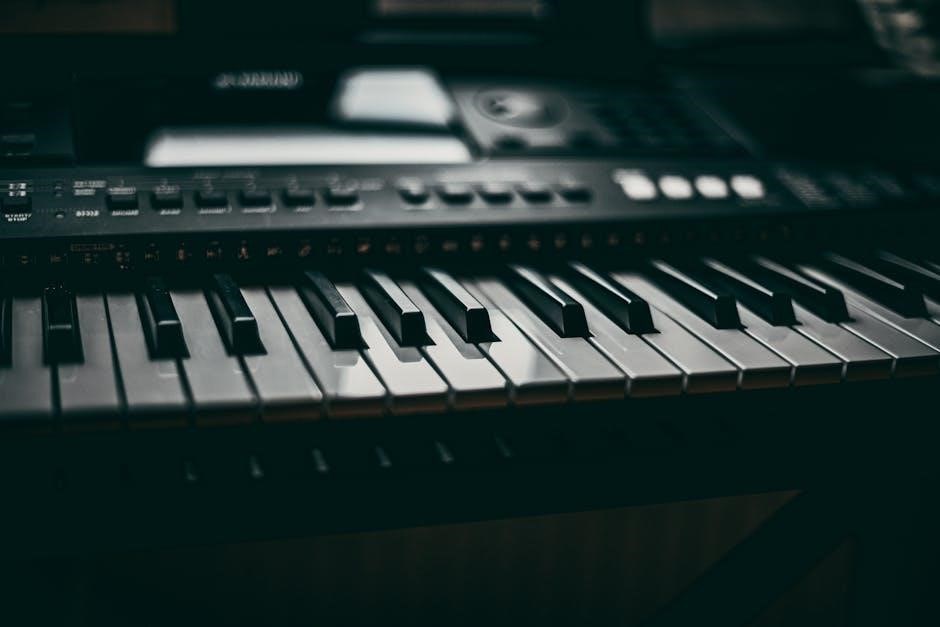
Learning Resources for Slash Chords
Explore slash chords piano PDF resources, including sheet music, eBooks, and guides. Find tutorials, exercises, and in-depth lessons online, perfect for mastering slash chords in Jazz and Blues.
8.1 Recommended Sheet Music and Tutorials
Discover slash chords piano PDF resources, offering detailed sheet music and tutorials. Websites like Jazz Piano University and Piano Nanny provide comprehensive guides. Downloadable eBooks such as The Art of Slash Chords and Piano Slash Chord Mastery are highly recommended. These materials include step-by-step lessons, chord charts, and exercises tailored for pianists. Many resources also feature MIDI files and audio examples to enhance learning. Start with beginner-friendly tutorials and progress to advanced techniques seamlessly.
8.2 Online Courses and Video Lessons
Explore online courses and video lessons to master slash chords on the piano. Platforms like Udemy, Coursera, and Skillshare offer in-depth courses. Websites such as MasterClass provide expert-led lessons. YouTube channels like Piano Lessons On The Web and HDpiano feature free tutorials. These resources cover chord construction, harmonic functions, and practical applications. Video lessons often include demonstrations, making complex concepts easier to grasp. Start with beginner-friendly courses and gradually explore advanced techniques to refine your skills.
8.3 PDF Guides and eBooks
Discover comprehensive PDF guides and eBooks to learn slash chords on the piano. Websites like Musicnotes, Piano Nanny, and Scribd offer downloadable resources. These guides provide detailed chord charts, harmonic explanations, and exercises. Many eBooks focus on practical applications, ensuring you can apply slash chords in real musical contexts. Look for titles that include exercises and examples to enhance your learning. These resources are perfect for self-study, allowing you to deepen your understanding of slash chords at your own pace.

Advanced Techniques with Slash Chords
Explore altered dominants, modal interchange, and advanced voicings to elevate your slash chord mastery. Resources like PDF guides and eBooks provide in-depth strategies for pianists.
9.1 Altered Dominant Slash Chords
Altered dominant slash chords add rich, complex harmonies to music. They combine a dominant chord with altered extensions (e.g., flat or sharp ninths, elevenths, or thirteenths). On piano, these chords are played with a slash indicating a specific bass note. PDF guides often include exercises and examples to master these advanced voicings, enhancing your ability to create tension and resolution in jazz and contemporary styles. Regular practice with such resources can deepen your understanding and application of altered dominants in various musical contexts.
9.2 Modal Interchange with Slash Chords
Modal interchange with slash chords involves borrowing chords from parallel modes or scales to create harmonic variety. Slash chords are ideal for this technique, as they can imply alternate tonalities. For example, a C major triad over an E flat bass (C/Eb) suggests a Lydian mode. PDF guides often provide exercises and progressions to master this concept, allowing pianists to explore rich, creative harmonies by blending modes seamlessly. This technique enhances harmonic depth and expands musical expression in various styles.
9.3 Advanced Voicing Techniques
Advanced voicing techniques with slash chords involve creative ways to arrange chord tones and extensions. Drop voicings, spread voicings, and upper structure triads are commonly used to add color and depth. These techniques allow pianists to imply complex harmonies while maintaining clarity. PDF guides often detail these methods, emphasizing how to balance inner voices and outer extensions. By mastering these voicings, pianists can achieve a polished, professional sound in jazz and contemporary music. Experimenting with different inversions and substitutions further enhances musicality and expression.

Real-World Examples of Slash Chords
Slash chords are widely used in various genres. Jazz often employs Dmaj7/C for complex harmonies, while pop may use G7/B for catchy bass lines. Classical pieces sometimes incorporate E/G# for rich textures, enhancing musical depth and expression across different styles.
10.1 Jazz and Blues Applications
In jazz and blues, slash chords like Cmaj7/E or D7/F# are used to create rich, intricate harmonies. They often appear in solos and improvisations, adding depth to progressions. Jazz pianists use slash chords to imply extended voicings, while blues musicians employ them for soulful, chromatic bass lines. For example, the Cminor9/Eb chord is commonly used in blues to create tension and release. These chords are essential for capturing the emotional essence of jazz and blues on the piano, offering a versatile tool for expression and musical storytelling.
10.2 Pop and Rock Music Examples
In pop and rock music, slash chords are frequently used to add harmonic interest and rhythmic drive. For instance, chords like C/G or D/F# are common in pop ballads to create smooth, flowing bass lines. Rock artists often use power chords with slash chord notation, such as E5/B, to emphasize heavy, driving rhythms. Elton John and The Beatles are known for incorporating slash chords in their hits, demonstrating their versatility in popular music. These chords enhance the emotional impact and energy of pop and rock compositions.
10.3 Classical Music and Slash Chords
Classical music often employs slash chords implicitly through figured bass notation, where specific bass lines guide harmonic movement. Composers like Bach and Mozart used intricate bass lines that resemble slash chord functions. While explicit slash chord notation is rare in classical scores, modern pianists apply slash chord concepts to enhance harmonic depth. For example, playing a C major chord over a G bass note (C/G) can evoke Baroque-style continuo textures. This technique bridges historical practices with contemporary harmonic exploration, enriching classical interpretations on the piano.
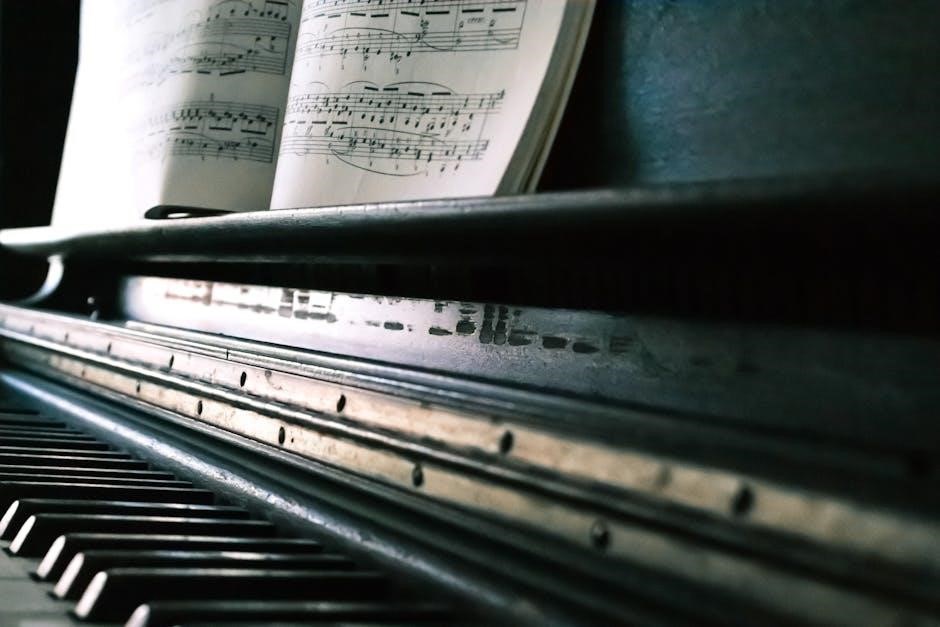
Troubleshooting Common Mistakes
Pianists often misidentify bass notes or use incorrect voicings. Practice reading slash chord notation carefully and focus on proper hand coordination to avoid timing and rhythmic errors.
11.1 Misidentifying the Bass Note
Misidentifying the bass note is a common mistake when playing slash chords on the piano. This occurs when the bass note is confused with the root or another chord tone. To avoid this, always prioritize the note after the slash, as it defines the bass. Practice reading slash chord notation carefully and ensure the left hand plays the correct bass note. This will help maintain harmonic clarity and proper chord function in your music.
11.2 Incorrect Chord Voicings
Incorrect chord voicings are a common issue when playing slash chords on the piano. This mistake occurs when the notes of the chord are arranged in a way that doesn’t align with the intended harmony. To avoid this, ensure the chord tones are played in the correct inversion, with the bass note prominent. Practice voicing chords in different octaves and listen to professional pianists to develop an ear for proper harmony. This will enhance your sound and prevent dissonance.
11.3 Timing and Rhythmic Issues
Timing and rhythmic issues are frequent challenges when playing slash chords on the piano. These problems arise when the bass note and chord are not synchronized, disrupting the overall rhythm. To resolve this, practice playing with a metronome to enhance timing accuracy. Start with slower tempos and gradually increase speed. Focus on maintaining a steady rhythm in both hands, ensuring the bass note aligns with the chord. This will improve coordination and create a smoother, more professional sound in your performances.
Consistent practice and mastery of slash chords will elevate your piano skills, offering richer harmonic depth and versatility in various musical styles and compositions.
12.1 Summary of Key Points
Slash chords are essential for pianists, offering harmonic complexity and versatility. They consist of a root and a bass note, differing from regular chords. By mastering slash chords, musicians can enhance their bass lines, explore various genres, and add depth to compositions. Regular practice and understanding their notation are crucial for effective use. Slash chords are invaluable in jazz, pop, and classical music, providing dynamic accompaniment and improvisation opportunities. They expand creative possibilities, making them a fundamental tool for pianists seeking to refine their skills and musical expression;
12.2 Encouragement for Further Practice
Mastering slash chords requires consistent practice, but the results are rewarding. Dedicate time daily to explore new chords and apply them in various musical contexts. Start with simple exercises and gradually incorporate them into songs. Experimenting with different genres will help solidify your understanding. Remember, practice enhances creativity and musicality. Embrace challenges and enjoy the journey of becoming proficient in slash chords—they will elevate your playing and open new possibilities for expression and improvisation.
12.3 Final Thoughts on Slash Chords
Mastery of slash chords is a powerful tool for pianists, enhancing both versatility and musicality; By understanding their structure and application, players can create richer harmonies and dynamic performances. Slash chords bridge the gap between melody and harmony, offering endless possibilities for expression. Embrace their complexity and explore their beauty—slash chords are a gateway to deeper musical understanding and artistic expression, making them an invaluable part of every pianist’s skill set.
